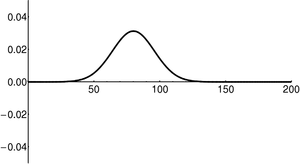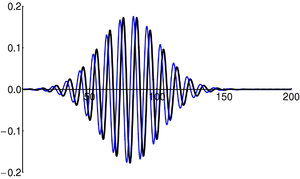Difference between revisions of "Quantum Mechanics"
KevinYager (talk | contribs) (→Measurement) |
KevinYager (talk | contribs) (→Entanglement) |
||
| Line 202: | Line 202: | ||
:<math>|\psi\rangle_A = \sum_{i} c^A_{i} |i\rangle_A</math> | :<math>|\psi\rangle_A = \sum_{i} c^A_{i} |i\rangle_A</math> | ||
:<math>|\phi\rangle_B = \sum_{j} c^B_{j} |j\rangle_B</math> | :<math>|\phi\rangle_B = \sum_{j} c^B_{j} |j\rangle_B</math> | ||
| − | However, if <math>\scriptstyle c_{ij} \neq c^A_ic^B_j</math>, then the | + | However, if <math>\scriptstyle c_{ij} \neq c^A_ic^B_j</math>, then the states are non-separable, or '''entangled'''. |
The entanglement of an observer (or simply measurement apparatus) can also be considered. For observer <math>\scriptstyle |\psi\rangle</math> performing measurement <math>\scriptstyle U</math> on system <math>\scriptstyle \sum a_n |S_n\rangle</math>: | The entanglement of an observer (or simply measurement apparatus) can also be considered. For observer <math>\scriptstyle |\psi\rangle</math> performing measurement <math>\scriptstyle U</math> on system <math>\scriptstyle \sum a_n |S_n\rangle</math>: | ||
Revision as of 10:38, 13 October 2014
Quantum mechanics is a theory that describes the interactions of all particles and systems. It underlies all physical phenomena, including scattering.
Contents
Wavefunction
A quantum system is completely specified by its Wave Function:
| Integral Notation | Dirac Notation |
|---|---|
The wavefunction is typically normalized:
| Integral Notation | Dirac Notation |
|---|---|
The distribution of the particle described by is given by:
| Integral Notation | Dirac Notation |
|---|---|
In the Copenhagen Interpretation, is the probability of finding the particle at location . In Universal Wave Function interpretations (e.g. MWI), can be thought of as the spatial distribution of the particle. The wavefunction contains all the information one can know about a system. It can thus be thought of as 'being' the particle/system in question. However, the wavefunction can be described in an infinite number of different ways. That is, there is not a unique basis for describing the wavefunction. So, for instance, one can describe the wavefunction using position-space or momentum-space:
These representations can be inter-related (c.f. Fourier transform):
State
Note that the wavefunction describes the state of the system; there are various choices of basis one can use as an expansion.
A basis should be orthonormal:
| Integral Notation | Dirac Notation | |
|---|---|---|
| normalized | ||
| orthogonal |
An operator defines a particular convenient basis: one can always expand using the basis defined by an operator, in which case the above are the eigenvectors (or eigenstates) of that basis. This can also be viewed as a vector in the Hilbert space. The Dirac notation (bra-ket notation) is useful in this regard. A particular state is a (column) vector:
Which is a 'ket'. We define a 'bra' (the 'final state') as a (row) vector:
And note that the 'bra' is the conjuagte transpose of the 'ket':
Wave packet
A wave packet is a localized wavelike perturbation. Particles in quantum mechanics can be thought of as wave-packets.
Note that "wave-particle duality" can be misleading. One can imagine a quantum particle as "both a wave and a particle"; however, it might be better to instead imagine it as a "wave packet". The 'particle' and 'wave' descriptions are really idealized limiting cases, which never appear in reality:
- A classical 'particle' is a point-like object. In QM would have a corresponding infinite spread in its momentum. Such an idealized (infinitely small) entity cannot truly exist.
- A classical 'wave' is a plane wave: an oscillation with a perfectly well-defined wavelength, extending infinitely in both directions. In QM, we indeed note that having a precisely-defined wavelength (momentum) implies infinite spatial spread (i.e. the wave fills the entire universe). Such a construct is not physically-realizable.
Heisenberg Indeterminacy Relations
(Also known as Heisenberg Uncertainty Principle.)
Superposition
If and are both allowed states for a given system, then the following state is also allowed:
This leads to a notable consequence:
Notice that the final terms represent 'interference' between the two constituent states. This interference has no classical analogue; it is a quantum effect. Thus a superposition is not merely a 'joining' of the two states (e.g. "the particle can be in state 1 or state 2"), but a truly coherent interference between the two states. The superposition may be more generally written as:
| Integral Notation | Dirac Notation |
|---|---|
The distribution of the particle described by is given by:
| Integral Notation | Dirac Notation |
|---|---|
Operators
Observables in QM appears as operators ().
Examples: TBD.
Measurement
The transition of the wavefunction into state can be thought of as:
When acting on a wavefunction with operator the probability that the wavefunction ends up in state is given by:
The solutions take the form of an eigenvalue problem:
The allowed solutions of the equation, for operator , involve an eigenstate with associated eigenvalue . A measurement on a quantum system can be thought of as driving the wavefunction into an eigenstate defined by the operator; the value of the associated observable is then fixed to be the corresponding eigenvalue. (As noted above, the probability of ending up in a particular eigenstate is regulated by the coefficient of that eigenstate in the original wavefunction decomposition.)
Expectation value
A given operator, e.g. , implies an expectation value (for state ) of:
If the system is in an eigenstate of the operator:
We know that:
And so:
In other words, the expectation value of an eigenstate is simply the eigenvalue.
Schrödinger Equation
Time-independent equation
This simplified version of the Schrödinger equation can be used to solve for allowed stationary states. The general form is akin to the eigenvalue problems noted above: the energy operator () acts on the system state () to yield an energy eigenvalue ():
For a single non-relativistic particle, the Hamiltonian is known and the Schrödinger equation takes the form:
Time-dependent equation
More generally, the time-evolution of the wavefunction should be considered. The full version of the Schrödinger equation thus includes time dependence:
Again for a single non-relativistic particle, we can write more specifically that:
Entanglement
When systems (or Hilbert spaces) A and B interact, they become entangled. Before the interaction, the two systems are simply a composite system:
At this level, states are separable. However, the composite system more generally should be written as:
If all the coefficients can be written as , then there is no coupling between the two states. We call the system separable, since it can be decomposed into the two sub-systems:
However, if , then the states are non-separable, or entangled.
The entanglement of an observer (or simply measurement apparatus) can also be considered. For observer performing measurement on system :
This leads to the evolution:
Where the right-hand-side describes an entanglement between the observer and the system being studied.
Density Matrices
The outer product of a ket with a bra defines a 2D matrix; i.e. a linear operator.
Density matrices can be a useful way to visualize the interactions between states of a system. For instance, a pure state is given by a density matrix that has only a single non-zero term, along the diagonal:
By comparison, a mixed state is one where more than one diagonal term is non-zero, but off-diagonal terms are zero:
The diagonal terms of the density matrix will be real numbers (and can be interpreted as probabilities). The above matrix describes a classical mixture of different states. In the Copenhagen interpretation, this would be described as a situation where the system will randomly collapse into one of the possible states. Under MWI, it would instead be said that the various states are now non-interacting, and thus will evolve independently.
The most general case is where the off-diagonal terms are non-zero. These terms represent the interference aspects. Thus this describes an entangled state:
The off-diagonal terms indicate the strength and nature of the interference between the states. During decoherence, these off-diagonal terms are driven towards zero.
Decoherence
TBD



















































![{\displaystyle E\Psi (\mathbf {r} )=\left[{\frac {-\hbar ^{2}}{2m}}\nabla ^{2}+V(\mathbf {r} )\right]\Psi (\mathbf {r} )}](https://wikimedia.org/api/rest_v1/media/math/render/svg/c51f6b87a0560f7ad79de32ad673a62fa4e32cab)

![{\displaystyle i\hbar {\frac {\partial }{\partial t}}\Psi (\mathbf {r} ,t)=\left[{\frac {-\hbar ^{2}}{2\mu }}\nabla ^{2}+V(\mathbf {r} ,t)\right]\Psi (\mathbf {r} ,t)}](https://wikimedia.org/api/rest_v1/media/math/render/svg/f2ae69999ed8b8551b217b9fbdcd8bf73490c82f)














